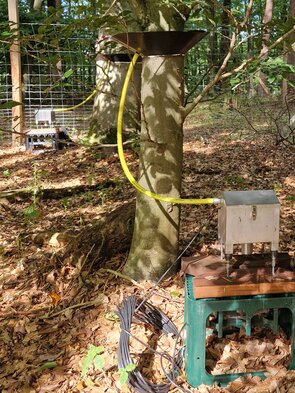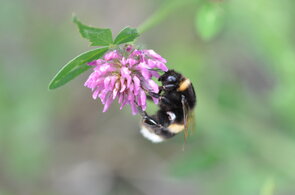eDNA analyses are particularly well suited to recording biodiversity in different habitats more accurately. The Thünen Institute has now launched the "EDNA Lab" for this purpose. It will be based in the EiLT landscape laboratory.


Beetles crawling through the grass. Fish swimming in the sea. Birds flying through the air. Every living creature leaves an invisible trail behind it, known as eDNA (environmental DNA). This environmental DNA is extremely interesting to scientists. This is because all monitoring methods for recording biodiversity have their limitations. Proven methods often only allow individual animal species to be detected. However, if researchers succeed in making eDNA visible, a whole new world of knowledge opens up.
"eDNA makes an entire ecosystem visible, not just individual animals or plants in the system," says Tanja Sanders from the Thünen Institute of Forest Ecosystems, who, together with Alexa Michel, initiated the EDNA Lab (Establishing eDNA as a tool for biodiversity monitoring and policy advice in landscape laboratories). Against the backdrop of widespread species decline in both animals and plants, this holistic view is crucial for providing scientifically sound advice on issues of nature conservation and agricultural, forestry and fisheries policy.
Monitoring is highly specialised
Until now, selected groups of organisms or biotopes have been examined in more detail with the aid of monitoring. However, all detection methods have methodological limitations. For example, insect monitoring using ground traps does not capture flying species. Tent traps ("Malaise traps") do capture flying species, but they do not catch ground-dwelling insects. Only by combining different methods can the range of detectable species and thus the significance and representativeness of a local sample be increased. eDNA can make all animals in different ecosystems visible. What's more, this can be done without having to catch a single insect, as eDNA analysis is minimally invasive. Using a technique known as "DNA metabarcoding", the DNA of all organisms contained in a sample is sequenced and compared with reference databases. This allows genera or species to be identified and their occurrence in the habitat from which the sample originated to be verified.
eDNA is particularly suitable for recording species diversity
In recent years, the method has proven to be particularly suitable for recording precise and comprehensive information on species diversity. The development of eDNA-based methods has also increased significantly at the Thünen Institute: at the Institute of Biodiversity, eDNA traces from nesting aids are analysed during wild bee monitoring in agricultural landscapes. At the Institute of Forest Ecosystems, a pilot study was conducted on eDNA in tree microhabitats in rainwater under tree canopies in cooperation with the Institute of Forest Genetics. At the Institute of Fisheries Ecology, research has already been conducted to determine species diversity in seawater. And at the Institute of Forest Genetics, the analysis of DNA residues from consumed food in wolf faeces has revealed a wide variety of prey animals. At the EiLT landscape laboratory in Trenthorst, these approaches are now being more closely linked with the help of the EDNA Lab, and issues are being addressed in an interdisciplinary manner. eDNA-based biodiversity recording in open land and forests is being further developed and established. To this end, new measurement and observation points are being set up in Trenthorst. These form the basis for continuous sampling, which in turn is needed to investigate the long-term effects of biodiversity-promoting measures.
What is being studied?
The measuring points on the EiLT study area should cover both forest and open land in a representative manner. Different eDNA substrates are collected. Precipitation collectors, trunk runoff collectors, litterfall collectors and pollen traps are used for this purpose. In addition, mulm (organic material in tree hollows) and flowers are collected by hand. In the forest, samples of precipitation, trunk runoff, mulm (plant debris in the soil), leaves, feeding traces and pollen are examined. In open land, the focus is on flowers and pollinating insects. In the forest, the main focus is on insects (pests and beneficial insects), small mammals and birds.

Contact:
Dr. Tanja Sanders
Thünen Institute of Forest Ecosystems
Phone: +49 3334 3820 339
E-Mail: tanja.sanders@thuenen.de